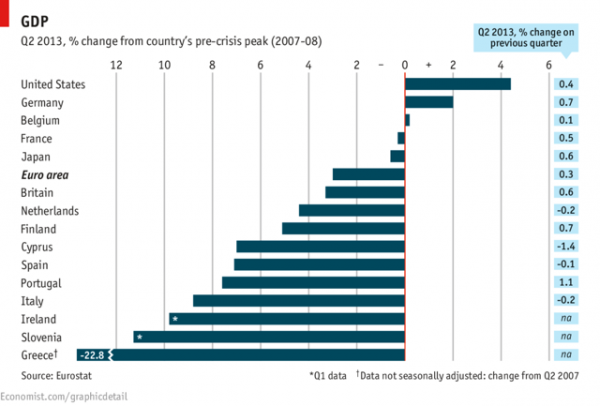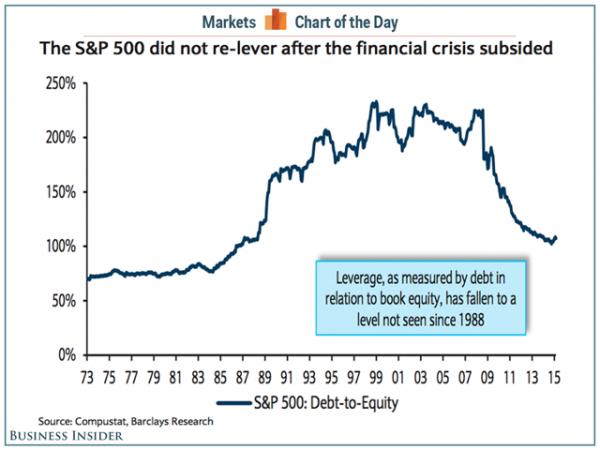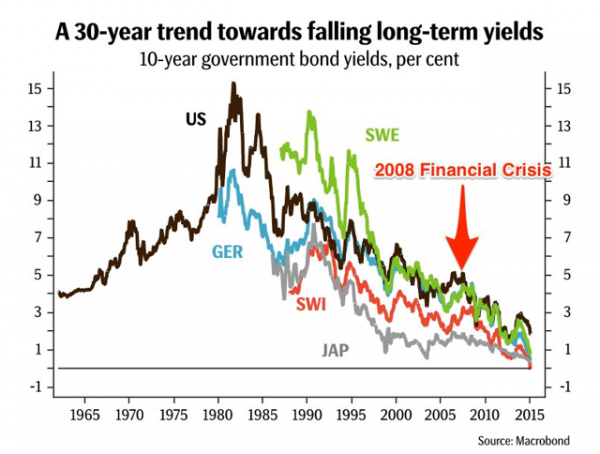When populist hoards vote their anger via the ballot box, it generally means what one pundit noted for time immemorial, “It’s the Economy, stupid!” The ravages of fifty years of outsourcing and off-shoring activities have devastated communities and families across the developed economies of the world, while developing countries have reaped the rewards of the most massive re-distribution of wealth that the world has ever witnessed. Economists are beginning to weigh in on what a Trump presidency might mean for the global economy and investors, but can anyone really jumpstart this car?
Donald Trump’s assessment of the global economic condition was bleak: “Believe me, we’re in a bubble right now. The only thing that looks good right now is the stock market and if you raise interest rates even a little bit, that’s going to come crashing down. We are in a big, fat, ugly bubble.“ Was this comment just one more bit of campaign bluster, or is their some truth in this dire warning? Yes, many have been sounding alarm bells for quite a few months, and there remain several optimists that are currently forecasting a new age of prosperity just around the corner. Who is correct? The past few years are not a convincing preview, as depicted by the rather sobering diagram below:

Can the United States and Germany pull the rest of the world out of the abyss? China, the rest of Asia, many developed economies, and the emerging markets of the world are depending upon it. Central banks have flooded markets with cheap money and abundant liquidity, forcing investors to push capital into extremely risky oriented assets, but the old investment rules do not seem to apply. An abundance of jobs, industrial output, and associated inflation have not been the result. It is as if the funds were poured down a black hole, but, unfortunately, the risk remains, as does the debt on the combined global balance sheet of our confused central banking community.
What is going on behind the numbers that is holding the economy hostage?
Much has been written about the Great Recession and how deeply it impacted our commercial ability to grow and prosper. The recovery has been long and slow, as many economists warned since banking institutions were at the core of problem. Banks do not recover easily from bloated balance sheets filled with non-performing loans. They typically stiffen loan requirements and refuse to invest in most anything that appears risky, including medium to small sized business enterprises. A recovery cannot get legs, so to speak, when the medium-to-small sector cannot function.
Central bankers freed up capital, flooded banks with liquidity, but the banks preferred to invest in the global bond casino of their own making. As we all know, betting on anything, including sovereign bond issues, is a zero-sum game – there are winners and losers, but the economic pie does not grow. It is easy, however, to point fingers at our beloved “banksters” and harshly accuse them of our travails, but the problem goes deeper than low-cost loans and bond casino investments.
Something is holding back our economic progress. Shock treatments in the form of QE, ZIRP, and now NIRF have failed to resuscitate the patient. Commodities have been on a downward spiral for five years and only now are beginning to show some life. Currency wars have erupted, regardless of entreaties from the IMF and the World Bank. Corporate profits and stocks have surged, although the future is in doubt. Inflation has been nonexistent, when the experts said it would accelerate beyond our control. Job creation has muddled along, increasing, but not bringing the desired path to overall prosperity.
What is the problem? A few economists are beginning to accept that there are many pieces to this puzzle that are not working together. Human psychology is such that, when times get extremely tough, it is a knee-jerk reaction to withdraw, the exact opposite of what is needed, i.e., investment, consumption, and building for a better long-term payoff. As economists scratch their collective noggin, the following themes emerge:
- Balance sheet recession era and associated debt cycles;
- Taxes and regulatory inhibitors;
- Secular issues like demographics, savings, and technology.
These broad areas are just a few of the so-called symptoms, but they are enough to understand for the moment. Uncertainty and volatility will plague us for some time, as each of these themes and others unravel before our eyes in the foreseeable future.
#1 -- Balance sheet recession era and associated debt cycles
Central bankers have used monetary policies to attack the problem of a low growth economy, but the expanded money supply has not increased investment in the right places, resulting in a liquidity trap, much like pushing upon a wet noodle. Companies and households have de-leveraged by paying down debt and letting the excess cash accumulate on the balance sheet, the reason it has been called a “balance sheet recession.” Japan has been fighting this phenomenon since the nineties with no apparent success. The following chart depicts this de-leveraging aspect from the perspective of S&P 500 participants:

What is the prudent response? Monetary tools have been exhausted. The IMF and others have been calling for fiscal stimulus, i.e., more infrastructure spending and increased borrowing from the government sector. Early signs from Trump sound favorable, as per this analyst: “Keynesians may now get what they wished for, perhaps not exactly in the form they wanted, but nevertheless. The incoming Trump administration is likely to embark on a combination of large tax cuts and substantial public spending increases, on things like infrastructure and defense.”
#2 -- Taxes and regulatory inhibitors
Business leaders and financial commentators frequently cite high taxes and abusive regulations as the cause for slow growth. Rates may appear high, but loopholes and deductions have effectively reduced rates on taxable income for decades. One expert notes, “It's hard to argue for a convincing link between high taxes and a lack of investment, growth and dynamism in the economy when corporate taxes amount to just 2% of GDP, when profits are near record highs and interest rates at record lows. There certainly isn't a lack of funds to invest. In fact, companies do invest, but much of it goes to share buybacks and dividends.”
In the aftermath of the banking crisis of 2008, regulations like the Dodd-Frank Act were adopted across the globe to curb banking extravagances and ensure that a repeat of bad behavior did not occur. Access to credit was restrained for smaller entities, but this trend has been long term, especially in the U.S.. Per one report, “The economy is engaged in a steady, secular decline in business dynamism. New business creation per capita fell by 50 percent between 1977 and 2011. Similarly, the firm entry rate - firms less than one year old as a share of all firms - fell by nearly half between 1978 and 2011.”
#3 -- Secular issues like demographics, savings, and technology
This last section is a catchall for everything else, if you will. Age demographics and birth rates have a way of slowing down an economy and cutting productivity when it is needed most, but a perplexing study was released a few years back by two economists at MIT that revealed that technology, for the first time in long memory, is destroying jobs more quickly than it is creating them. Automation and the Internet have redesigned the workplace and put an emphasis on skill sets that are not in abundance.
Millennials are now scoring lower on skill assessment surveys than expected, leaving the business world groping for talent. According to Erik Brynjolfsson, one of the authors of the MIT study, “Productivity is at record levels, innovation has never been faster, and yet at the same time, we have a falling median income and we have fewer jobs. People are falling behind because technology is advancing so fast and our skills and organizations aren’t keeping up.” The problem with this form of “slack”, however, is that new investment will not necessarily create jobs that can be readily filled. This type of structural issue is at the heart of many of our challenges.
The issue of shortsightedness by business leaders and families, alike, is also disturbing. Savings on both a corporate and household level are piling up, as if saving for that rainy day that every doomsayer on the planet has been predicting since the Great Recession ended. To some degree, longer life spans have also encouraged more savings, another demographic issue. Companies have cut back on investments, a fairly shortsighted approach, since the very future of their earnings stream depends upon it. Profits have piled up as cash on the balance sheet, propped up by stock buy-back programs that minimize the denominator when it comes time for performance reporting.
There are two aspects of secular stagnation that have been happening for decades. Yields across the board have been in decline since the eighties (see chart below). This trend adversely impacts the attractiveness of investment projects. Capital has nowhere to go, a form of stagnation. Worse yet, technology has created a situation where productivity has increased quickly, the product consequently gets cheaper more rapidly, and capital then moves to less efficient arenas. ZIRP and NIRF policies have also pushed capital into areas where allocations would have been highly suspect in a normal world, but now low growth is perceived to be the “new normal”. Structural issues, unfortunately, take time to solve.

What are the near-term impacts for our foreign exchange markets?
As financial markets rebound at the prospect of fiscal stimulus from a Trump administration, it is more than likely that the Fed will follow through with an interest rate hike in December. Per one pundit, “If the Fed raises its overnight lending rate in December as most expect them to do, and if the dollar pushes above resistance levels as they did last year, an imperfect storm may develop.” Translation: Equities may not be in vogue anymore.
Concluding Remarks
The global economy is still stuck in low gear. Central bankers have overextended their monetary policy arsenal to no avail. Fiscal stimulus is next on the global agenda, and, from early indications, Trump and his buddies are eager to cut taxes, increase infrastructure spending, and expand military outlays. Will these measures kick start the global economy into a higher gear? It remains to be seen, but structural problems take time to fix, and effective economic policy teams take time to form. Whatever the case, expect uncertainty and volatility, the recipe for success in the forex trading arena.
Risk Statement: Trading Foreign Exchange on margin carries a high level of risk and may not be suitable for all investors. The possibility exists that you could lose more than your initial deposit. The high degree of leverage can work against you as well as for you.